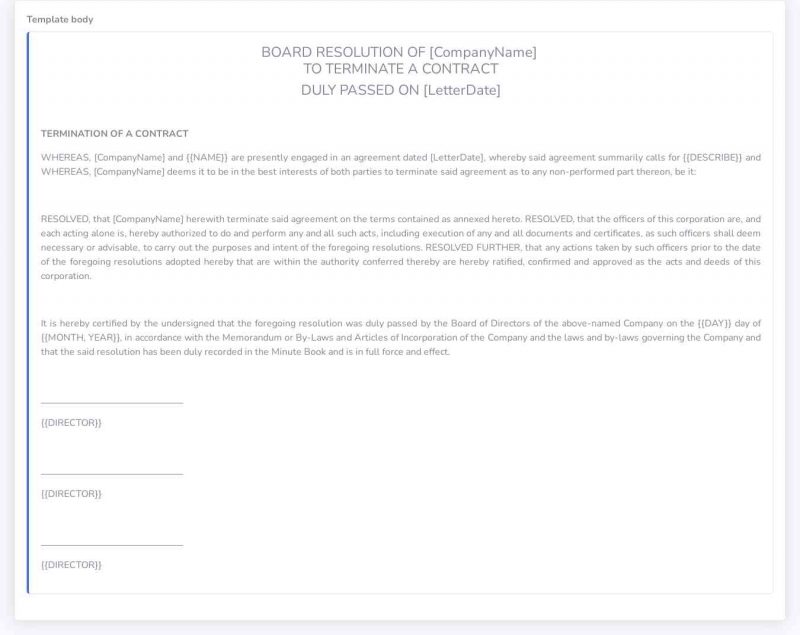Board resolution to terminate an employee is a critical decision that requires careful consideration of legal, ethical, and practical implications. Understanding the legal framework, board resolution process, and post-termination considerations is essential for employers to navigate this complex matter effectively.
A board resolution to terminate an employee can be a daunting experience, but having a contract of employment can provide some much-needed protection. Contracts typically outline the terms of employment, including termination procedures, and can help ensure that both parties are treated fairly.
Benefits of having a contract of employment as an employee can include clarity on job duties, compensation, and benefits, as well as protection against arbitrary termination. Understanding these benefits can empower employees and make the termination process less stressful.
This comprehensive guide will provide a step-by-step analysis of board resolution to terminate an employee, empowering employers with the knowledge and tools to make informed decisions that protect their organization and uphold employee rights.
The board resolution to terminate an employee can be a costly process. Studies have shown that the average cost of firing an employee can range from a few thousand dollars to over $100,000. These costs include severance pay, unemployment benefits, and legal fees.
As a result, it is important for employers to carefully consider the financial implications of terminating an employee before making a decision.
Board Resolution to Terminate an Employee
Terminating an employee is a significant decision that should be handled with care and in accordance with legal requirements. A board resolution to terminate an employee provides a formal and documented record of the decision-making process and the reasons for termination.
A board resolution to terminate an employee should be made in accordance with the basic employment rights for an employee, as outlined in basic employment rights for an employee . These rights include the right to due process, the right to a fair hearing, and the right to representation.
Failure to adhere to these rights can result in legal challenges to the board resolution.
Legal Framework

Terminating an employee based on a board resolution must be supported by valid legal grounds. These grounds may include:
- Breach of employment contract
- Violation of company policies
- Poor performance
- Misconduct
- Reorganization or downsizing
It is crucial to adhere to employment contracts and labor laws to ensure that the termination is fair and compliant.
The board’s resolution to terminate an employee should not be taken lightly. It’s essential to consider the average cost of replacing an employee , which can be significant. The cost includes not only the financial implications but also the time and effort required to find, hire, and train a new employee.
Therefore, the board must weigh the potential costs and benefits of termination carefully before making a decision.
Epilogue
Terminating an employee via board resolution is a multifaceted process that demands a delicate balance between legal compliance, ethical considerations, and organizational impact. By adhering to the guidelines Artikeld in this guide, employers can ensure that terminations are conducted fairly, respectfully, and in accordance with best practices.
The board resolution to terminate an employee can be a complex process. One potential complication is if the employee has attempted to gain access to a network using an employee. Attempting to gain access to a network using an employee is a serious offense that can lead to termination of employment.
If the board is considering terminating an employee for this reason, it is important to carefully consider all of the facts and circumstances.
Remember, the well-being of both the organization and the employee should remain at the forefront of any termination decision, fostering a positive and productive work environment for all.
A board resolution to terminate an employee is a difficult but necessary step. It’s important to handle the situation with compassion and respect, and one way to do that is to write an appreciation letter to the employee. This letter can express your gratitude for their contributions to the company and wish them well in their future endeavors.
It’s a small gesture that can make a big difference in how the employee feels about their departure. Even in the case of a board resolution to terminate an employee, it’s important to remember that they are a valuable member of the team and deserve to be treated with respect.
Questions Often Asked: Board Resolution To Terminate An Employee
What are the common reasons for terminating an employee via board resolution?
Common reasons include performance issues, misconduct, restructuring, and redundancy.
What are the legal grounds for terminating an employee based on a board resolution?
Termination must be based on legitimate reasons, such as performance deficiencies, misconduct, or business restructuring.
How should employers communicate the termination decision to the employee?
Communication should be clear, respectful, and professional, delivered in person or via a formal letter.
Board resolutions to terminate an employee can have significant financial implications for businesses. These resolutions not only involve severance pay but also the average cost of an employee with benefits, which includes salaries, health insurance, and retirement contributions. According to a recent study, the average cost of an employee with benefits is around $47,000 per year.
This means that terminating an employee can cost a business a substantial amount of money. Therefore, it’s crucial for boards to carefully consider the financial impact of employee terminations before making a decision.
In cases of board resolution to terminate an employee, one of the indicators that an employee is no longer employed by the company can be the automatic reply set up on their email account. As described in automatic reply no longer an employee , when an employee is terminated, their email account may be disabled or reassigned, resulting in an automatic reply informing senders that the employee is no longer with the company.
This can serve as a confirmation of the board resolution to terminate the employee’s employment.